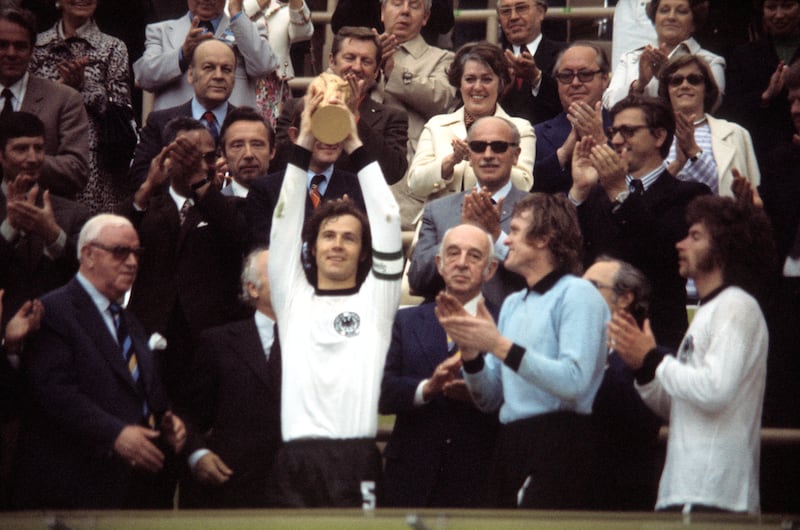“For me,” Helmut Schön said of Franz Beckenbauer in February 1965 after calling him up to the West Germany team for the first time, “he is the player of the future. Maybe not in midfield, perhaps up front.”
People were always looking at Beckenbauer and seeing in him a being from another age, and that meant that, for a long time, nobody really knew what to make of him. He was handsome, charismatic and languid, a player of effortless elegance guaranteed to enrage those who believed the game was about industry, sweat and graft. He was technically gifted. He saw things others didn’t. He had grace and intelligence.
From his teens it was obvious Beckenbauer would be a player of the highest level. But in what position? Nobody could work it out. And so he effectively invented a role for himself. Beckenbauer is now considered the great example of the libero, but he was not a libero in the Italian sense, sitting behind a tough-man marker and initiating attacks with long-range passes. As he himself said, if he resembled anybody in Helenio Herrera’s great Internazionale side that popularised the idea of a libero by winning two European Cups with their catenaccio, it was the left-back Giacinto Facchetti, a fine defender who would surge forward to create angles in midfield and join the attack.
Beckenbauer’s early career was a tale of a player seeking a role. When he made his Bayern debut in 1964 as an 18-year-old, in the promotion playoffs against St Pauli, he operated on the left wing. In his next game, against Tasmania Berlin, he dropped back to play as a centre-half when Rainer Ohlhauser was pushed up front as Bayern chased an equaliser and did well enough to play there again against Borussia Neunkirchen. In the second group game against St Pauli, he started as a half, then dropped in to the defence to help deal with the threat of Guy Acolatse, and ended up as a forward as Bayern chased a winner.
In pictures: Inter Milan v Barcelona - Two games, 13 goals and possibly the best Champions League tie ever
Frattesi fires Inter into Champions League final after Barcelona fall short in seven-goal epic
‘No fear’: Declan Rice rejects Wayne Rooney criticism and sets sights on Arsenal comeback
Damien Duff and Stephen Bradley trade more verbal shots – what we learned from Monday’s League of Ireland action
West German sides in those days tended play an adaptation of the W-M, in which one of the halves would drop back behind the centre-half to play as an Ausputzer – literally, a cleaner – but he had no creative brief as he would have done in Italy. Rather, the centre-half picked up the opposing centre-forward but had a limited licence to step forward, knowing he had cover behind him. Beckenbauer took that far further than anybody had before.
Bayern missed out on promotion by a point that season, but cruised into the Bundesliga the following campaign with Beckenbauer as the regular centre-half despite constant newspaper talk that he might be better deployed as one of the more creative midfielders.
Zlatko Cajkovski, the Bayern coach, seemingly had similar doubts and, that summer, signed the combative Dieter Danzberg to operate as his centre-half, allowing Beckenbauer to move further forward. But Danzberg was sent off in the opening game of the following season, a derby against 1860 Munich, and banned for eight weeks. Beckenbauer stepped into his position and never left it, the crowning glory of a fine first top-flight campaign coming against SV Meiderich in the 1966 German Cup final.
Beckenbauer’s forward surges had been restricted by having to deal with centre-forward Rüdiger Mielke, but with eight minutes remaining and Bayern leading 3-2, Ohlhauser won the ball back and suddenly became aware Beckenbauer had set off. He picked him out, Beckenbauer ran on and scored the decisive goal from the edge of the box. His role as a libero was confirmed and, with Georg Schwarzenbeck an essential but largely unsung stopper alongside him, would go on to underpin all Bayern’s success in the 1970s.
For the national team, Beckenbauer’s role was more contested. For that first game, in February 1965, an unofficial friendly against Chelsea, Beckenbauer operated in midfield as Schön experimented with a back four. Other than two games on a tour of South and Central America in 1968, when Willi Schulz was used as a man-marker and Beckenbauer had to take his role in the back four, that was where he remained until 1971 when Schön finally agreed to allow Beckenbauer to play as the libero.

The following year, Beckenbauer was at the heart of the West Germany side that, in beating England 3-1 at Wembley in the first leg of the Euro 72 quarter-final, produced a mesmerisingly brilliant half-hour. It was, L’Équipe said, “football from the year 2000″. This, at last, was Beckenbauer’s age.
The truth, though, was however advanced West Germany appeared by comparison with Alf Ramsey’s fading England, it was football of the early 70s. Trying to keep the game in the shade of the main stand in the heat of Léon during the 1970 World Cup, it’s said, had taught West Germany how possession could be manipulated, and the freedom Beckenbauer had in stepping out of the backline, offering an extra man, was critical in allowing them to operate like that. The style, a sort of Total Football without the pressing, brought both the 1972 Euros and the 1974 World Cup.
Time eventually caught up with the man from the future. As a coach Beckenbauer was a conservative. “A defensive stance,” he said, “corresponds to Germany nature ... we get stuck in, we story the opponent’s game and the force our game on to him.”
When Klaus Augenthaler suggested switching to a back four, Beckenbauer insisted “our character, our system” was a libero plus markers. It brought two World Cup finals in 1986 and 1990, the latter of them won, but probably delayed the advent of pressing, leading to the lost decade of the 90s (the weird outlier of winning Euro 96 notwithstanding) and subsequent reboot.
But why would Beckenbauer have been a great theorist? Why would he, as a manager, have been part among the tactical avant-garde? As a player, by being who he was, without having to conceptualise it, he had changed the way the game was played. He emerged as a player out of time, and made football conform to him. – Guardian
- Find The Irish Times on WhatsApp and stay up to date
- Our In The News podcast is now published daily – Find the latest episode here















